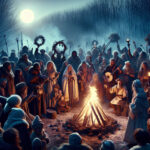The Norse pantheon of gods and goddesses is one of the oldest and most extensive ever created. From Odin, the all-father and ruler of Asgard, to Thor, the god of thunder and lightning, to Freya, the goddess of fertility and love, the Norse gods have become widely known in modern popular culture. In this article, we will explore the fascinating mythology of the Norse pagan gods and explore their stories and the roles they played in Norse culture.
Norse Pagan Gods are an integral part of Norse mythology. They are the gods, goddesses, giants, elves and other various supernatural beings that inhabit the nine worlds of the Norse cosmos. Norse mythology is the religion of the ancient Norse people who lived in what is now Scandinavia, the northernmost part of Europe. The pantheon of Norse gods includes Odin, Thor, Freya, Loki, Heimdall and many others.
Who are the Norse Gods?
The Norse pantheon is made up of several gods and goddesses, each with their own distinct personalities and powers. The most important of these deities are Odin, Thor, Freya, Loki and Heimdall. Odin is the supreme ruler of Asgard, the home of the gods, and is the god of wisdom and magic. Thor is the god of thunder and a protector of mankind. Freya is the goddess of love and beauty, and is also a goddess of war. Loki is the god of mischief and chaos, and is a trickster god. Heimdall is the god of vigilance and the guardian of Asgard.
What do the Norse Gods Represent?
The Norse gods and goddesses represent different aspects of the natural world, human life and the cosmos. Odin is associated with wisdom, magic and death. Thor is associated with strength, protection and justice. Freya is associated with love and beauty. Loki is associated with chaos and mischief. Heimdall is associated with vigilance and protection.
How do the Norse Gods Interact with Humans?
The Norse gods interact with humans in different ways. Odin is believed to have given humans the gift of knowledge and wisdom, and is also said to have created the world. Thor is said to protect humans from danger and evil, and is also said to be the protector of Asgard. Freya is said to have blessed humans with love and beauty. Loki is said to bring chaos and mischief to humans, and Heimdall is said to protect Asgard from danger.
What are the Norse Creation Stories?
The Norse creation stories tell of how the Norse gods created the world. According to Norse mythology, the world was created when Ymir, the primordial giant, was slain by Odin and his brothers Vili and Vé. From Ymir’s body, they created the nine realms of the Norse cosmos. In another version of the story, the gods used an ash tree, Yggdrasil, to create the world.
Where Can I Learn More About Norse Gods?
If you’re interested in learning more about Norse gods and mythology, there are many resources available. Books and websites about Norse mythology are a great way to start. Additionally, there are many museums and historical sites in Scandinavia that focus on Norse mythology and culture.
In conclusion, Norse Paganism is an ancient religion that has been around for centuries and continues to be practiced today. It is a polytheistic religion with many gods and goddesses that are all interconnected and part of a larger cosmic system. Norse pagan gods and goddesses have been worshiped and revered for centuries and are still seen as powerful and important figures in Norse mythology. Norse paganism is still practiced today and is a vibrant and important part of many people’s spiritual lives. It is a religion that honors and respects the power of nature and its gods and goddesses, and encourages its followers to live in harmony with the natural world.





